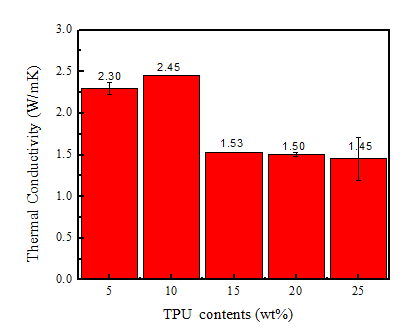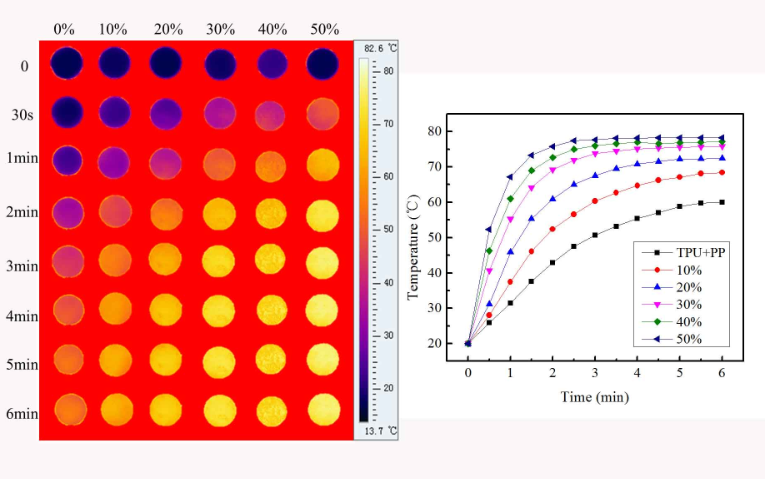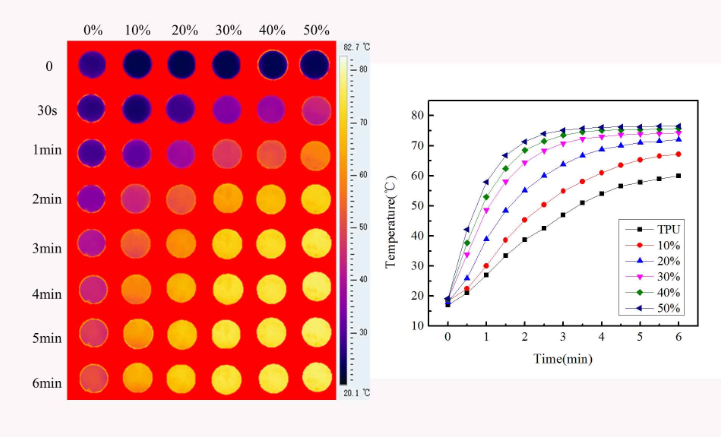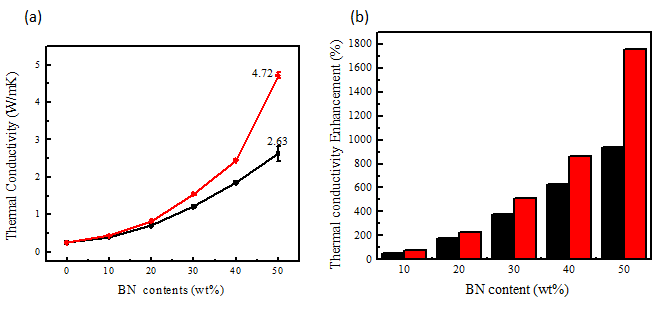氮化硼聚丙烯聚氨酯三元复合材料的制备与导热性能研究毕业论文
2020-04-25 19:40:52
摘 要
随着科技的高速发展,集成电路中电子器件的体积越来越小、质量也越来越轻,但同时使用过程中会产生大量热量,这会对它们的稳定性、可靠性以及寿命产生影响。聚合物基复合材料质量轻,并具有电绝缘性。本文以热塑性聚氨酯(TPU)为基体,以氮化硼(BN)为导热填料,再加入聚丙烯(PP)微球,通过溶液混合、热压工艺制备了具有隔离结构的BN/PP/TPU三元导热复合材料。热压成型温度为175℃(低于PP熔融温度),使得TPU/BN混合物填充于PP微球的缝隙间,构建出连续互通的三维导热网络。
纯TPU的热导率为0.22W/( m•K),研究发现,TPU/PP的比例为1:5时BN/PP/TPU三元复合材料的热导率最大。当BN含量为50wt%时,二元体系的热导率达到了2.63W/( m•K),三元体系的热导率高达4.72W/( m•K),三元体系较二元体系增长了79.5%。
关键词:复合材料 聚氨酯 氮化硼 导热系数 热导率
Preparation and thermal conductivity of boron nitride / polypropylene / polyurethane ternary composites
Abstrcat
With the rapid development of science and technology, the size and quality of electronic devices in integrated circuits are getting smaller and lighter, but at the same time, a large amount of heat will be generated during the use process, which will have an impact on their stability, reliability and life span. Polymer-based composites are light in quality and have electrical insulation. BN / PP/ TPU thermal conductivity composites were prepared by mixing solution and hot pressing process with BN as heat conduction filler and PP microspheres. The hot pressing molding temperature is 175℃(below PP melting temperature), so that the TPU/BN mixture is filled with gaps in the PP microsphere to construct a continuous three-dimensional thermal conduction network.
The study found that the TPU/PP ratio was 1:5,The TPU/PP/BN ternary composite has the highest thermal conductivity. When the BN content is 50 wt %, the thermal conductivity of the pure TPU is 0.22 W/( m•K), the thermal conductivity of the binary system reaches 2.63 W/( m•K), and the thermal conductivity of the ternary system is as high as W/( m•K). The triple system is 79.5 % higher than the binary system.
Key Words:composite;polyurethane;boron nitride;thermal conductivity
目 录
摘要 I
Abstrcat II
第一章 绪论 1
1.1 研究背景 1
1.1.1 引言 1
1.1.2 氮化硼简述 1
1.1.3 聚氨酯简述 2
1.2 导热材料 2
1.2.1 导热机理 2
1.2.2 导热填料 2
1.3 导热高分子基复合材料 3
1.3.1 本征型导热高分子 4
1.3.2 简单填充型高分子 4
1.3.3 结构控制填充型导热高分子 4
1.4 导热材料的应用 5
1.4.1 LED设备领域的应用 5
1.4.2 电子封装领域应用 6
1.4.3 电池领域应用 7
1.4.4 太阳能领域应用 7
1.5本研究目的和内容 7
第二章 实验部分 9
2.1实验原料及设备 9
2.2 实验过程 9
2.3 实验测试方法 10
2.3.1红外热成像 10
2.3.2 Hot-Disk热导率测试 10
2.3.3光学显微镜 11
第三章 结果与讨论 12
3.1不同TPU与PP比例的样品 12
3.1.1不同TPU与PP比例的样品红外热成像结果 13
3.1.2不同TPU与PP比例的光学显微镜结果 14
3.1.3 不同TPU与PP比例的热导率测试结果 15
3.2不同BN添加量的样品 15
3.2.1不同BN添加量样品的红外热成像结果 16
3.2.2不同BN添加量样品的光学显微镜结果 17
3.3二元与三元体系导热材料的比较 17
3.3.1二元体系的红外热成像结果 18
3.3.2二元体系的热导率测试结果 19
3.4本章小结 19
第四章 结论与展望 20
4.1 结论 20
4.2 展望 20
参考文献 21
致谢 23
第一章 绪论
1.1 研究背景
1.1.1 引言
随着科技不断进步,对于导热材料的研究也与时俱进。导热材料的应用范围极其广泛,比如:工业生产、航天航空、化工热交换、发光二极管照明灯、电子电器等等。导热材料应具备良好的热交换性能,根据组成的不同分为两种:传统导热材料与聚合物导热材料[1]。传统导热材料一般由金属(如Al,Mg,Cu等)加工而得到,常见的有铝、镁、铜制品等,由于金属材料的导电性、电磁屏蔽效应以及耐腐蚀性能差且加工成型困难、成本高昂,限制了在很多方面的应用;聚合物导热材料以聚合物为基体,向基体中加入导热填料,可使得复合材料具有良好的导热性能、力学性能以及电绝缘性、耐化学腐蚀、易于加工等优点,此外,在质量减轻的同时还可以降低制作成本[2]。
热耗散对电子器件的性能、寿命和可靠性至关重要。随着电子产品的小型化、集成化、功能化和新型应用的出现,如三维芯片堆叠结构、柔性电子学和发光二极管等应用[3,4],热耗散成为一个具有挑战性的问题。随着高度集成化及功率的不断增加,令产品在使用过程中会大量的热量,如果热量无法及时耗散,逐渐堆积的大量的热量会使得产品老化、性能下降,甚至引起元件烧毁,更甚者可能会引发火灾。热耗散成为一个极具挑战性的问题,制备具高导热绝缘性能、综合性能优异的导热材料有着十分重要的价值。
相关图片展示:






您可能感兴趣的文章
- 可聚合高分子模板增强制备高耐久超疏水涂层文献综述
- PVC/ABS合金的制备及性能研究开题报告
- 设计具有增强的赝电容及电催化性能的Co3O4/NiCo2O4双壳纳米笼结构外文翻译资料
- 光子上转换手性液晶:显著放大的上转换圆偏振发光外文翻译资料
- 氧空位型LiV3O8纳米片的快速稳定储锂性能研究外文翻译资料
- 应用于高性能钙钛矿太阳能电池的电子传输层的前体工程外文翻译资料
- 复合材料科学与技术 ——含碳纳米管的多孔导电弹性体复合材料悬浮在共连续聚合物的狭窄孔隙中的混合纳米复合材料外文翻译资料
- 一种用于先进锂硫电池源自聚罗丹宁纤维素的氮硫双掺杂碳外文翻译资料
- 短玻璃纤维增强聚丙烯控制界面和力学性能参数外文翻译资料
- 含Ca0的LaCO.0H纳米齿轮及其发光和脱NOx性能外文翻译资料




